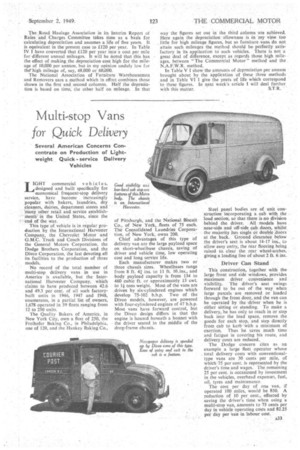Multi-stop Vans
Page 59

If you've noticed an error in this article please click here to report it so we can fix it.
for Quick Delivery
Several American Concerns Concentrate on Production of Lightweight Quick service Delivery Vehicles
LliGHT commercial vehicle s, designed and built specifically for economical frequent-stop delivery service, have become increasingly popular with bakers, laundries, dry pleaners, dairies, department stores and 'many other retail and service establishmenti' in the United States, since the
: 'end of the war.
This type•of vehicle is in regular production by the International Harvester Company, the Chevrolet Motor and G.M.C. Truck and Coach Divisions of the General Motors Corporation, the Dodge Brothers Corporation, and the Divco Corporation, the last devoting all its facilities to the production of three models.
No record of the total number of multi-stop delivery vans in use in America is available, but the International Harvester Company. which claims to have produced between 42.6 and 49.3 per cent. of all such factorybuilt units in 1946, 1947 and 1948, enumerates, in a partial list of owners, 1,678 operated in 39 fleets ranging from 12 to 250 units.
The Quality Bakers of America, in New York City, own a fleet of 250, the Freihofer Baking Co., in Philadelphia, one of 120, and the Hankey Baking Co., of Pittsburgh, and the National Biscuit Co., of New York, fleets of 75 each. The Consolidated Laundries Corporation, of New York, owns 200.
Chief advantages of this type of delivery van are the large payload space on short-wheelbase chassis, saving of driver and vehicle time, low operating cost and long service life.
Each manufacturer makes two or three chassis sizes. Wheelbases range from 8 ft. 41 ins. to 11 ft, Wins., and body payload capacity is from 134 to 460 cubic ft. or approximately 13 cwt. to l tons weight. Most of the vans are driven by six-cylindered engines which develop 75-102 b.h.p. Two of the Divco models, however, are powered with four-cylindered engines of 47 b.h.p. Most vans have forward control, but the Divco design differs in that the engine is housed beneath a bonnet with the driver seated in the middle of the drop-frame chassis. Steel panel bodies are of unit construction incorporating a cab with the load section, so that there is nodivision behind the driver. All models have near-side and off-side cab doors, whilst the majority has single or double doors at the back. Ground clearance below the driver's seat is about 14-17 ins., to allow easy entry, the rear flooring being raised to_ clear the rear wheel-arches, giving a loading line of about 2 ft. 6 ins.
Driver Can Stand This construction, together with the large front and side windows, provides maximum driver convenience and visibility. The driver's seat swings forward to be out of the way when large parcels are removed or loaded through the front door, and the van can be operated by the 'driver when he is either sitting or. standing. To make a delivery, he has only to reach in or step back into the load space, remove the goods for each stop, and step, directly from cab to kerb 'With a minimum of exertion. Thus he saves much time and fatigue in covering his route, and Newspaper delivery is speeded delivery costs are reduced., up by Dit,C0 vans of this type. The Dodge concern cites as an Ease of entry and exit to the example a large fleet operator whose cab is a feature. , total delivery costs with conventional type vans are 30 cents per mile, of which 75 per cent, is represented by the driver's time and wages. The remaining 25 per cent. is occasioned by investment in the vehicles, overhead expenses, fuel, oil, tyres and maintenance.
The cost per day of one van, if operated 100 miles, would be $30. A reduction of 10 per cent., effected by 'saving the driver's time when using a multi-stop van, amounts to 75 cents per day in vehicle operating costs and $2.25 per day per 'van in labour cost.




























































































